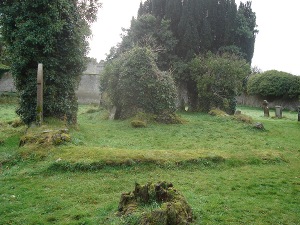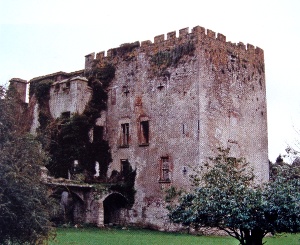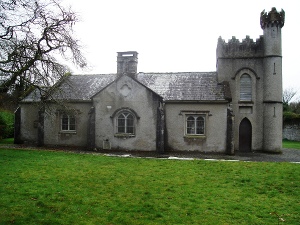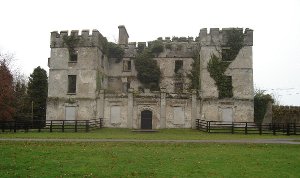The History of Donadea Demesne
Published in the Kildare Nationalist, 20th February 2009
Donadea Forest Park is one of the most popular outdoor venues in both county Kildare and the west Dublin region. There is a very important history contained within the walls of this ancient demesne, which begins in the early history period and continues for almost two thousand years.
In the pre-Christian period the ‘Sligh Mór’ one of the five ancient roads of Ireland passed through Donadea. A small section of the road, survives today in the demesne. It extends for approximately 80 meters in an east-west direction from the Castle entrance at the Kilcock Avenue to St Peters Church. In the year 455 AD, St Patrick travelled on this road and founded the first Church at Donadea. The site of this Church is in the Chancel section of the ruined medieval church in Donadea graveyard. All Churches in Ireland with placenames that begins with Domhnach meaning Sunday were founded by St Patrick; there were so called because he marked out their foundations on a Sunday. The Irish for Donadea is Domhnach Dheá. St Patrick is also credited with building a Church nearby at Dunmurraghill. This Church flourished until it was destroyed in 1035 by a Viking raiding party and never recovered as an important religious centre. Fortunately, Donadea Church was untouched by the raiders and survived as a religious centre.
The Normans came to Donadea in the 12th century and established a Manor. They built their Manor house on or close to the present Castle. This structure was the first of many Castles on the site throughout the Middle Ages. There were many powerful Norman lords of Donadea in this period and in 1558 the famous Aylmer family acquired the Manor.
In 1581, Gerald Aylmer built a new Tower in Donadea. The Tower was not fully completed until 1624 and is now the oldest part of the Castle. In 1626, he repaired the medieval Church in Donadea and built a new extension in which he established his family burial plot. In the extension he also constructed an Altar Tomb monument as a burial memorial for his family. Gerald was titled by the Crown and became the first Baronet of Donadea.
The Aylmers were connected with the various conflicts and rebellions over the next two centuries. During the wars of the 1640’s Andrew Aylmer the 2nd Baronet of Donadea supported the rebels and was imprisoned at the beginning of the war. Although he was a brother-in-law of the Lord Lieutenant, the Earl of Ormond, there were no favours granted to him. In 1642 Ormond sent an army to capture Donadea Castle which was stoutly defender by his sister Ellen Aylmer. The Castle, nevertheless, was captured and burned. Ellen, however, was not imprisoned and subsequently rebuilt the Castle.
In 1689 after the Battle of the Boyne another Lady Ellen Aylmer, was in charge of the Castle. She was the widow of the 3rd Baronet and was outlawed due to her support for King James. However, she managed to hold on to the Castle and lands under the terms of the Treaty of Limerick.
In 1736, Gerald the 5th Baronet died leaving an only son Fitzgerald who became the 6th Baronet. He was only one year old when his father died and was subsequently raised by his Mother and her relatives who were members of the Established Church. Fitzgerald, subsequently conformed to the Established Religion. In 1773, he built a new house in front of the Castle and incorporated the Tower in his new residence.
The 7th Baronet, Fenton is famous in local history as the man who founded the Kildare Hunt. He is also famous as a Yeoman leader during the Rebellion of 1798. In the period leading up to the rebellion there was an attempt to burn Donadea Castle. During the rebellion Fenton’s kinsman William Aylmer of Painstown was the leader of the local rebels. This led to a split among the general Aylmer family. For over a century the two branches of the Aylmer’s were buried side by side in the Church in Donadea. However, it is likely that Fenton in the period after 1798, did not relish the prospect of his branch continuing to be buried in the same burial vault as the Painstown branch. This may have been a factor when he decided not to modernise the medieval Church which was in need of repair in the first decade of the 19th century. Instead, he decided to build a new Church and Mausoleum adjacent to the older Church. The old Church was named ‘St Peter’s’ and this name was retained as the name for the new church when it was consecrated in 1813. The Altar Tomb was removed and erected at the side of the altar in the new Church. The remains of Fenton Aylmer’s ancestors were then removed from the old Church and re-interred in the new Mausoleum. The remains of the Painstown Aylmers remained in their ancestral burial vault in the old Church where they continued to be interred for at least another generation. Much of the old Church was demolished at this time.
Fenton’s son, Gerald George the 8th Baronet held the lands of Donadea between 1816 and 1878 and he is accredited with most of the construction work that is visible in Donadea demesne today. He began his building program in the 1820’s by re-routing the roads away from the Castle and the construction of a high wall enclosing the demesne. Gate lodges were then built at all the entrances. He also built a new grand entrance known as the Lime Avenue. In 1827 he completely remodelled the front of the Castle which gave it an attractive bow shaped appearance. It has been suggested that he employed the renowned architect Richard Morrison to design this new structure. The older cabin type dwellings close to the castle were demolished and new estate houses built at the Range. To the west of the Castle he built an 8 acre area of gardens and paddocks, surrounded and sub-divided by walls. In the Castle yard he built dwellings for staff and elaborative farm buildings. He also constructed the artificial lake and the Ice House. Large areas of the demesne were planted and by the time of his death Donadea demesne was listed as one of the finest parkland settings in the country. Outside the demesne he was involved in numerous construction projects including the famous ‘Aylmer Folly’ namely the Tower on the summit of the hill of Allen.
Gerald George’s grandson Justin the 10th Baronet died unmarried in 1885. His sister Caroline inherited the Castle and much of the demesne, while the title of Baronet passed to a cousin. Caroline Aylmer was the last person to live in the Castle, she died unmarried in 1935 and her property was sold to the Department of Lands.
In 1981, Paddy Power, the Minister for Lands designated the area of the demesne held by his department as Donadea Forest Park. Under the management of Coillte a new era of history then began which transformed Donadea demesne to a modern Forest Park. Unfortunately, the buildings in the Park continue to deteriorate. In recent times the local community development group, Tir na Mona, have become extensively involved in conjunction with Coillte in developing the Forest Park. Firstly, by promoting the use of the Park and secondly, by initiating projects and fundraising for the development of the Park. Many successful projects have been completed including the erection of the Donadea 9/11 monument which was unveiled by Michael Fitzpatrick Mayor of Kildare in 2003.
Today Donadea Forest Park is a quaint country oasis where peace and tranquillity can be enjoyed by all.




